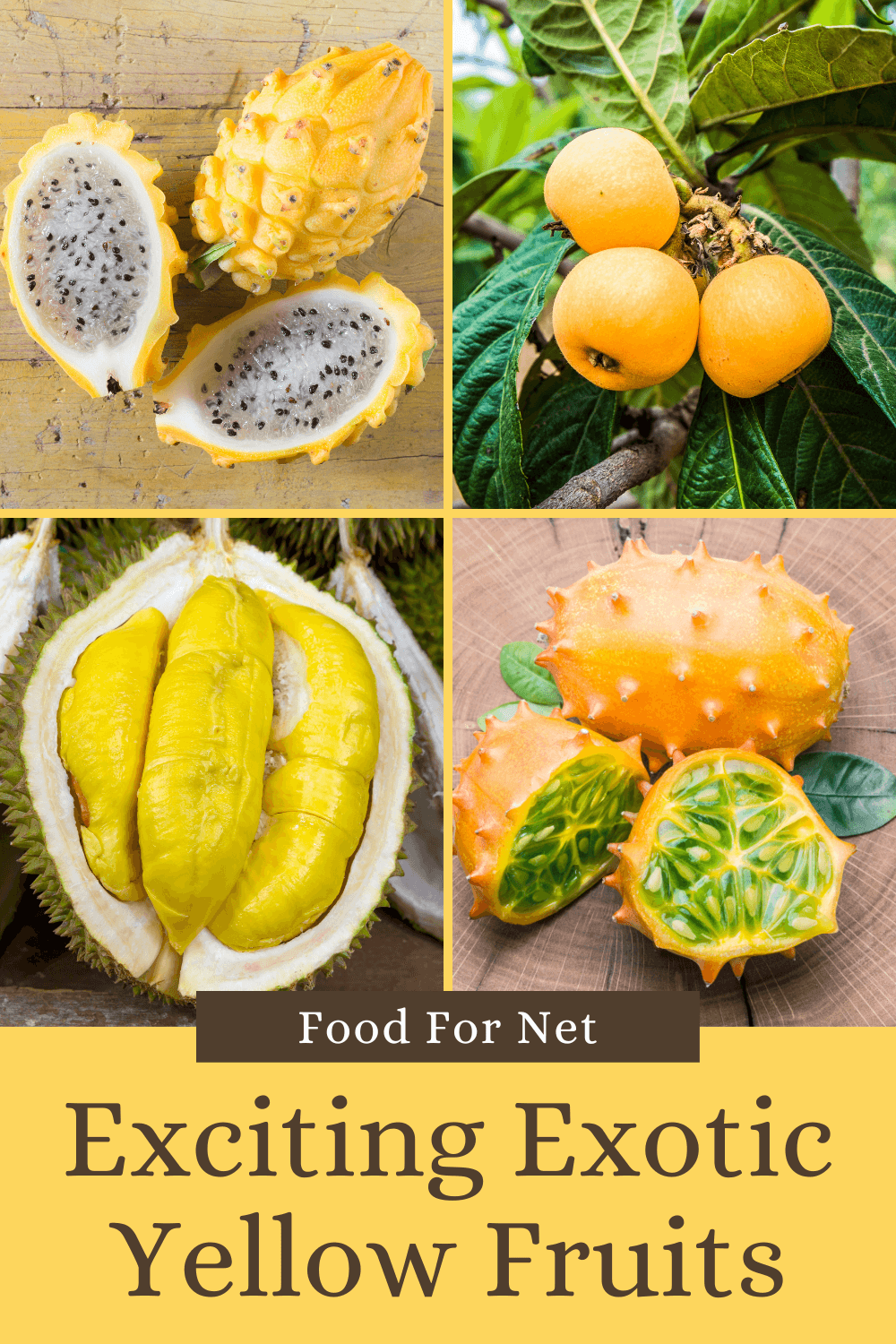
Fruit often isn’t all that exciting. Sure, it’s refreshing and delicious, but who doesn’t get bored by the same selection time and time again? I know I do. Even farmer’s markets are limited, as you’re mostly getting different varieties of fruits that you’re already familiar with. If you’re going specific, and looking for exotic yellow fruits, then you’re in an even tougher situation!
It doesn’t need to be this way, though. There’s an almost endless selection of exotic fruit out there, including plenty of types you’ve never seen before. To make your journey easier, this post is narrowing the field and just focusing on exotic yellow fruits (we have a similar list of exotic green fruit, in case you need even more ideas).
Even then, there are a whopping 34 fruits featured on list – and there’s no way I found all of them.
Some of these fruits may be familiar already. You might see them in specialty stores or be able to order them online. Of course, they’re often not cheap. You might pay $5, $10, or more for a single piece of fruit.
Other fruits might only be found in certain parts of the world – often because they’re too perishable to transport or there simply isn’t enough demand. Keep your eyes out, though, you never know what you’ll find.
Exotic Yellow Fruits (With Pictures!)
Barrel Cactus Fruit
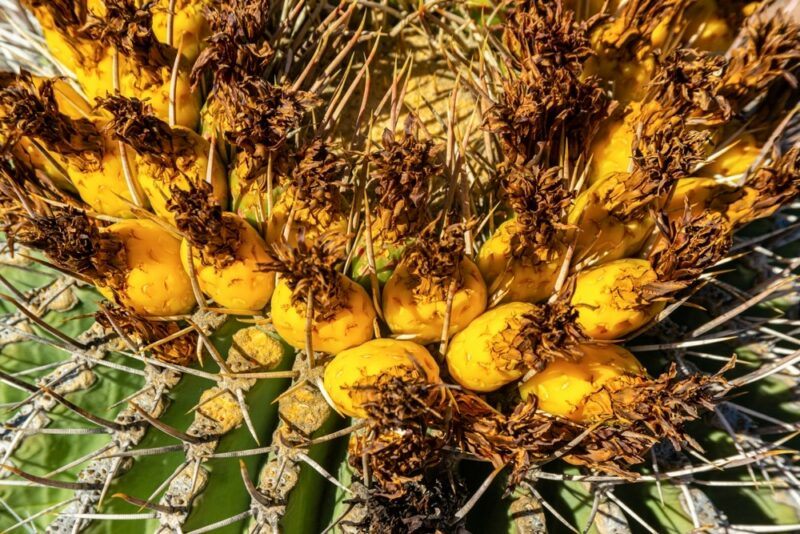
Eating fruit from a cactus sounds like a strange idea, right? After all, cacti are covered in spines and don’t usually feature on the dinner table.
Yet, the fruit of the barrel cactus is entirely free from spines. This fruit is surprisingly delicious too, with a tart and lemon-like flavor that’s complemented by a taste much like guava.
The natural tartness of the fruit makes it perfect in sweet dishes. However, some people use barrel cactus fruit in salads instead, which also works well. With a little experimentation, you might even find a completely different way to use the fruit.
Buddha’s Hand
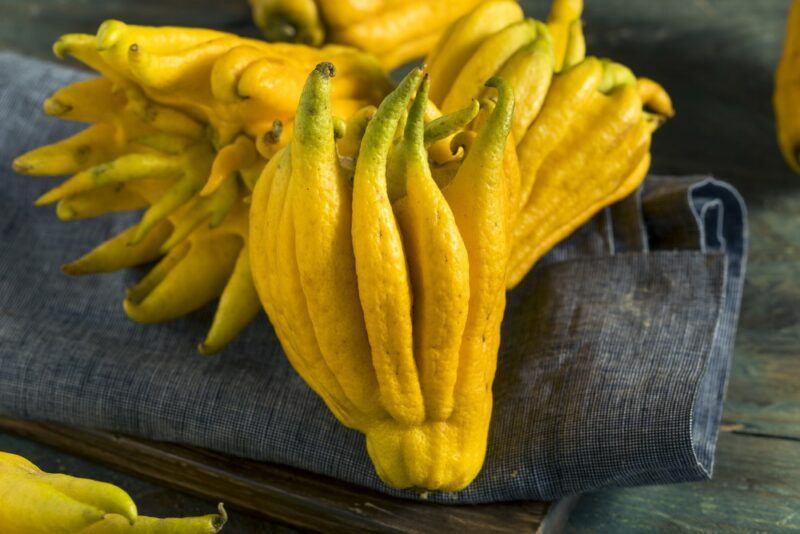
These bright yellow fruits look amazing. There are different varieties, which vary in the appearance of the ‘fingers’. Sometimes you’ll see a splayed version that looks like an open hand, while other times, the fingers are much closer together.
The most appealing thing is the scent of the fruit, which is bright, vibrant, and citrusy. That’s why Buddha’s hands are often used ornamentally.
There are other unusual features too, as there isn’t any juice or pulp. The pith isn’t bitter like the pith in lemons, meaning that you can eat it.
Most of the time, though, Buddha’s hand zest is used in small amounts to flavor desserts, salads, and other dishes. It works well in cocktails too. In fact, you can use it much like lemon zest.
Balata Fruit
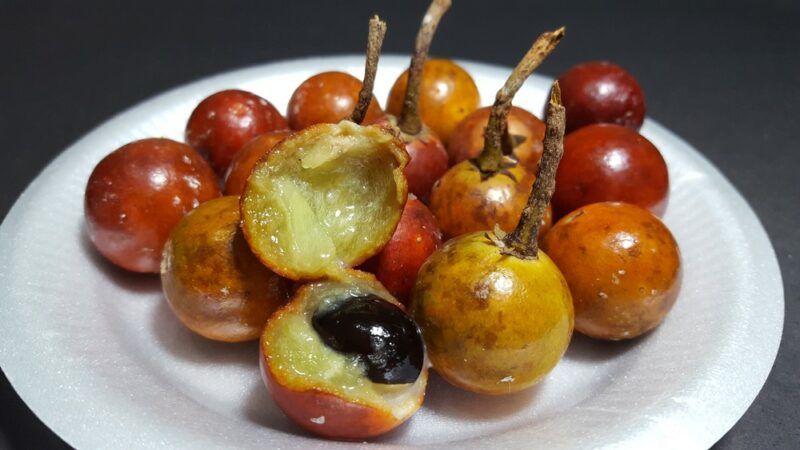
Balata fruit are rare, most commonly found in the Caribbean, plus South America and Central America. The skin of the fruit is inedible, as is the seed.
This leaves you with the white juicy flesh that has a sweet and musky flavor.
There are other varieties as well, including those where the flesh is orange rather than yellow. Regardless of the color, it’s an interesting fruit to experiment with.
Canary Melon
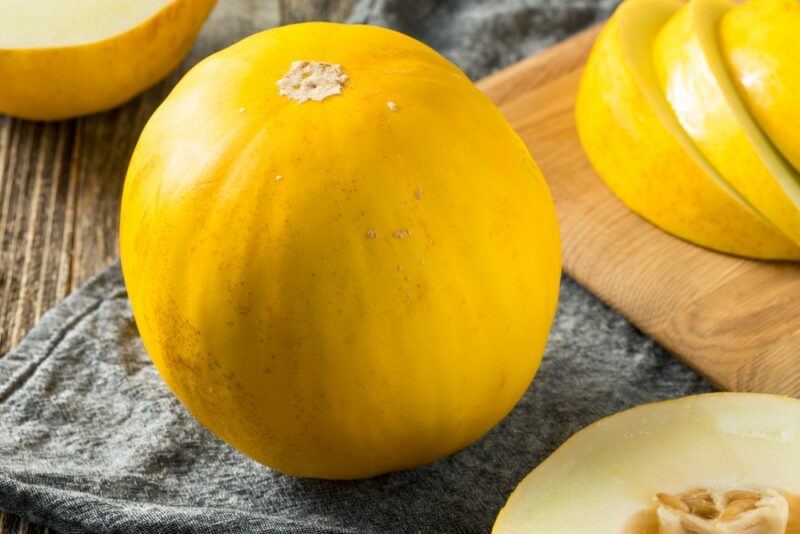
This bright yellow fruit is a type of winter melon. The tender flesh ranges from white to light green and has a sweet flavor. The flavor is subtle enough to work well in many dishes, including salads and soups.
There’s a tropical aspect to the fruit’s aroma, one that’s reminiscent of bananas and pineapples.
Canistel
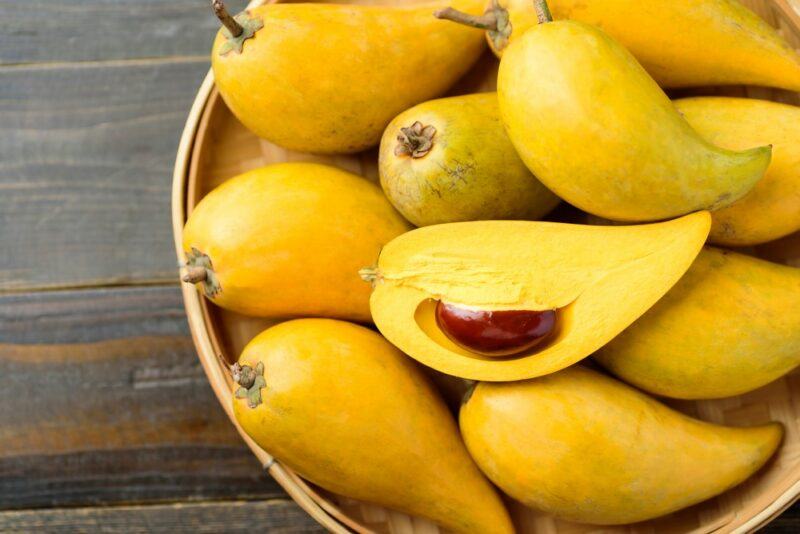
This unusual fruit goes by a few names, including eggfruit and tiesta. It’s also unlike anything else.
For one thing, canistel fruit isn’t juicy at all. It’s somewhat chewy instead. The texture is also sometimes described as being like the yolk of a hard boiled egg, which is where the name eggfruit comes from.
While the fruit can be eaten as-is, it is more commonly used to make jam and marmalade, or in other recipes.
Horned Melon
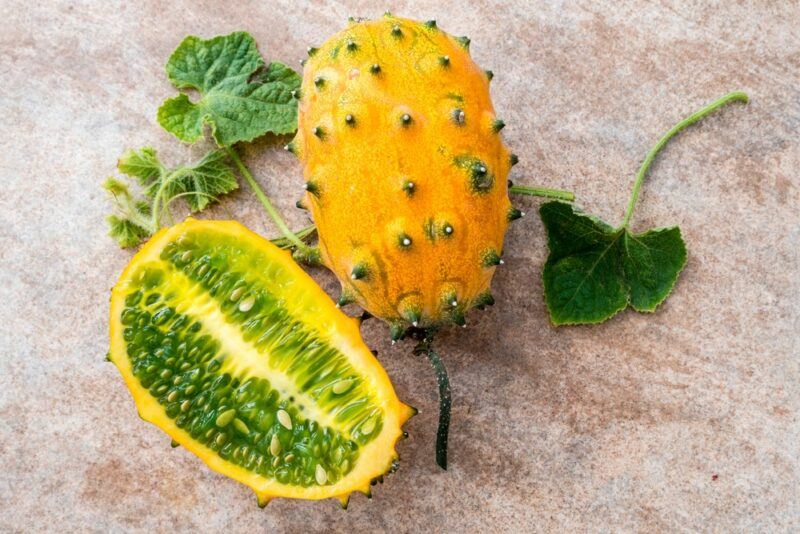
The horned melon, or kiwiano is strange from start to finish. It really is spiked or horned, although you can hold it and cut it open without too much difficulty.
Then you get to the green pulpy flesh, which sometimes earns the fruit the name ‘jelly melon’. This pulp can be eaten on its own with a spoon or perhaps used as a garnish. It’s excellent in fruit salads too (much like passionfruit pulp).
Even the flavor is unexpected, as the fruit somehow tastes like kiwifruit and cucumber at the same time. There are also hints of banana, just to make things more interesting.
Naranjilla
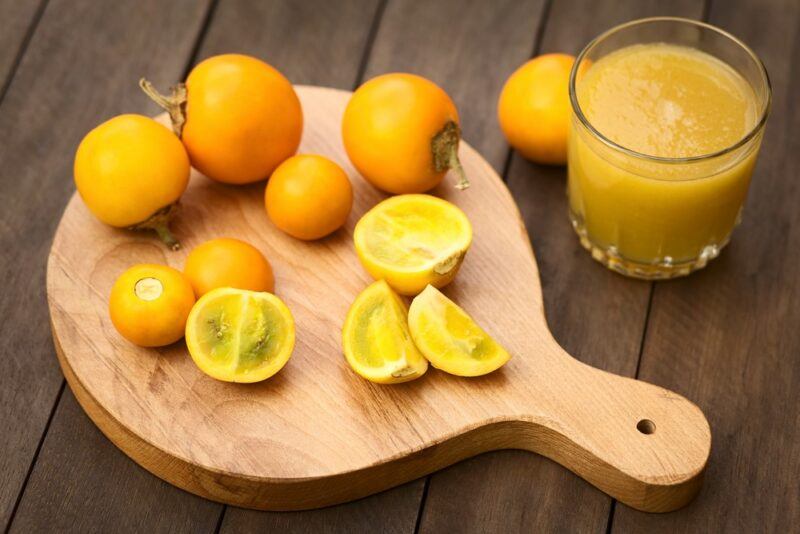
Naranjilla or lulo fruits are small and round, with an orange or yellow peel when fully ripe. Some varieties have a jelly-like green pulp that’s segmented into four, while others have yellow pulp instead.
While the flavor can vary, citrus notes are often prominent. Other fruit nuances may be present too, including kiwi and pineapple.
The fruit can be eaten as soon as it is picked, but continues to ripen over time. This is useful if you order it online, as companies can ship the fruit out before it becomes too ripe and loses resiliency.
Persimmon
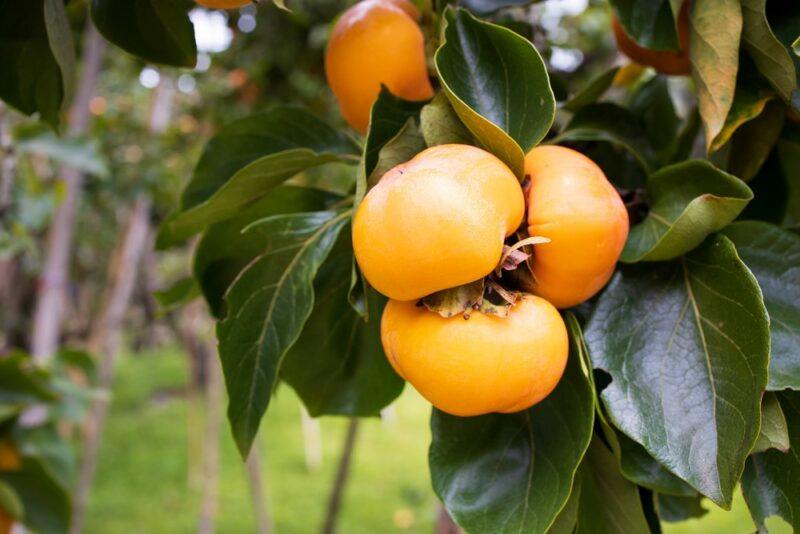
Persimmons are pretty well-known these days and have become easy to find. They’re still exotic fruits, though, and are unusual when compared to most other fruits.
The fruit can be either stringent or non-astringent. The difference is important, as astringent persimmons are horrible if eaten underripe.
For astringent persimmons, you need to wait before they’re extremely soft before eating. If you have a non-astringent type instead (like a Fuyu persimmon), it’s fine to eat them while they’re still firm.
Like many of the fruits on this list, persimmons are often orange or red, but there are yellow ones too, including vanilla kaki persimmons.
Golden Raspberries
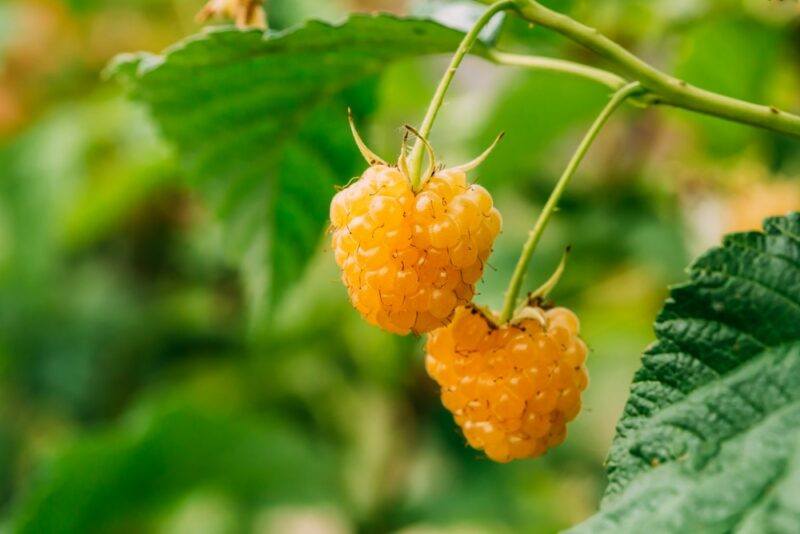
Golden raspberries are exactly what they sound like – a raspberry variety that produces yellow fruit rather than red ones. Golden raspberries tend to be sweet and delicious, making them popular.
The most unexpected aspect is that the berries often have a more intense raspberry flavor than traditional red raspberries.
Oh, and don’t worry, these berries aren’t genetically modified. They’re the result of a natural mutation.
Araza
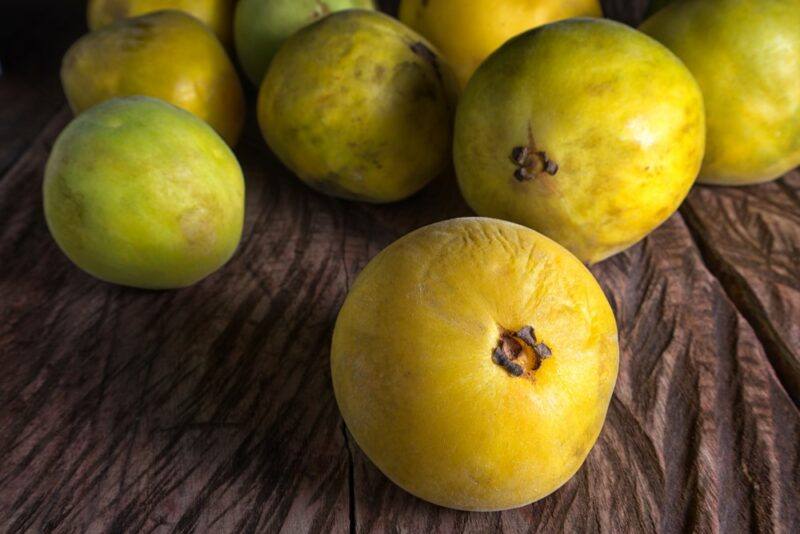
Araza is a rare species that comes from the same family as guava. When ripe, the fruit is round and yellow, but it’s not eaten on its own very often.
The problem is that very sour. So, instead, araza is used in recipes. Jellies, jams, fruit preserves, and marmalades are just a few examples.
While you can sometimes order araza-related products online, you won’t find the fruit itself very often, as it is easily damaged. That said, the plant is sometimes grown in California, as it can help land to recover.
Calamondin Limes
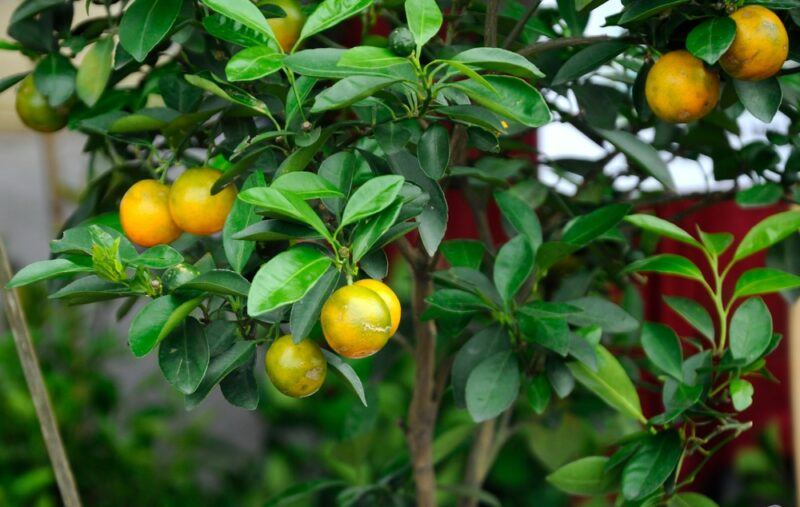
While calamondin limes are a type of citrus fruit, they’re not what you might expect. For one thing, the skin is typically orange or yellow, as is the flesh (a few varieties remain green when ripe, but this is less common).
The limes are aromatic and tart, but not to the same degree as traditional limes. Instead, the limes are sweet enough to be enjoyed raw.
The skin of the limes is edible as well. Interestingly, this is slightly sweeter than the flesh of the fruit.
Mountain Pawpaw

This fruit is a South American native which, not surprisingly, is common in mountain regions. When ripe, both the skin and flesh of the fruit are bright yellow.
The flavor is similar to the more familiar pawpaw, but this version isn’t as sweet.
Santol
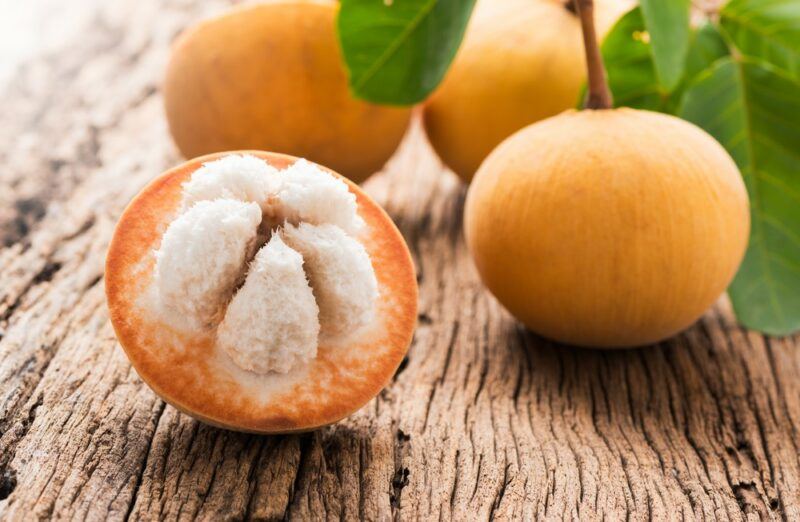
The santol fruit starts green and gradually ripens to a golden yellow. The fruit isn’t smooth though. Instead, it has a leathery texture and even a little fuzziness.
The interior of the fruit is interesting too, with white pulp that has a consistency that’s almost like cotton. Within this are a few seeds. The seeds are inedible, but the pulp itself is delicious.
The taste changes based on the variety and maturity of the fruit. Some are sweet and even taste a little like candy, while others have a distinct sour flavor.
Starfruit
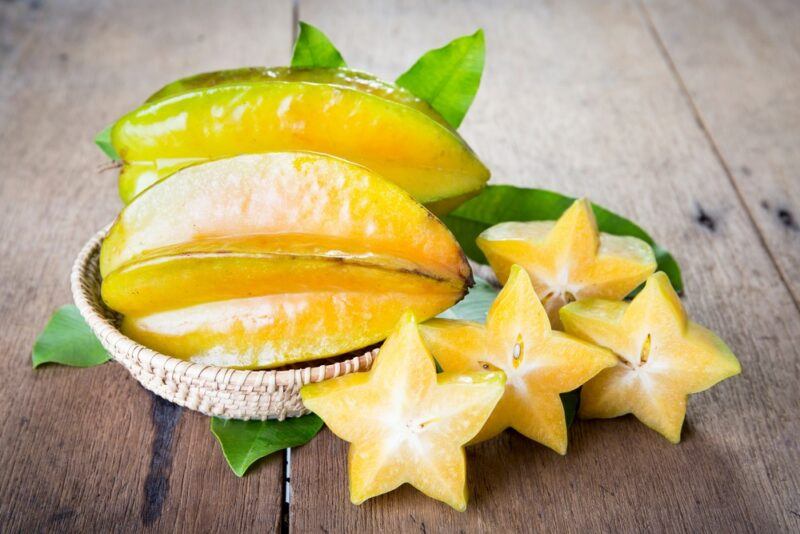
Starfruit was once incredibly obscure. These days it’s much more common – and popular – for its shape, flavor, and potential health benefits.
The name really says it all, as the fruit is shaped like a five-pointed star. This is particularly noticeable when you cut it into slices. The small stars look amazing on salads and in plenty of other dishes.
There are two main versions of the fruit. One is smaller and sour, while the other is larger and has a sweeter taste.
It’s important to only eat starfruit when it is ripe. Here, the fruit should be almost entirely yellow, with just tiny amounts of green.
Babaco
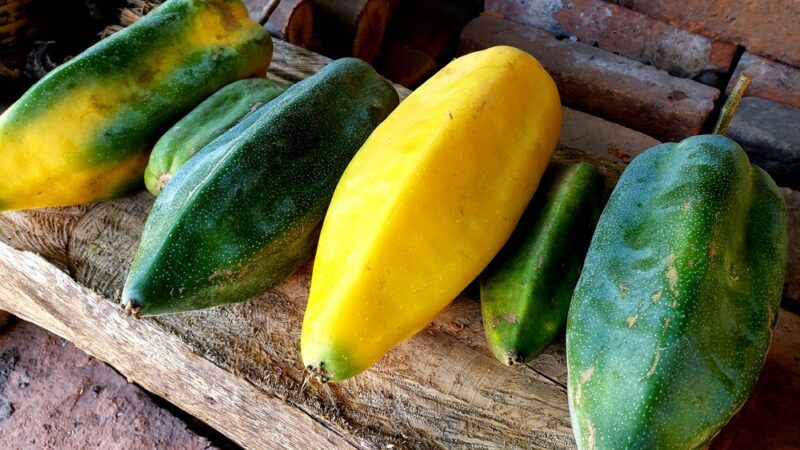
Babaco also goes by the name champagne fruit – and certainly looks strange. It’s a long and large melon, with a five-pointed shape that somewhat resembles a star (but, the star is less defined than with starfruit).
The flesh is white, with a similar consistency to other melons. Tropical flavors dominate, with touches of kiwi, papaya, and pineapple also coming into play.
It’s not an easy fruit to grow, which is why it’s rarely produced commercially. However, it can be worthwhile for home growers, especially as the fruits are so large and are packed with nutrients.
Cape Gooseberries
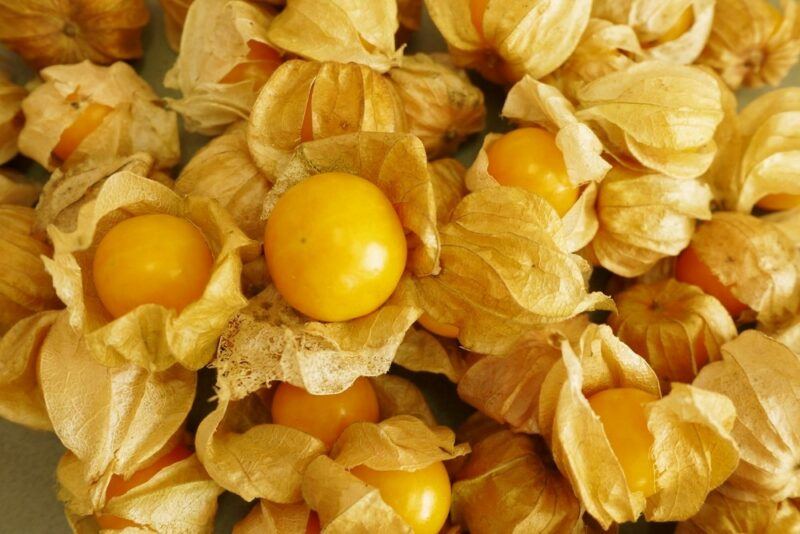
Cape gooseberries are another relatively common type of exotic fruit. They’re fascinating too, as the bright yellow fruits are enclosed in an almost transparent papery husk.
This husk makes the gooseberries fun to unwrap. The husks are a little more frustrating if you need to process many of the fruits to make jam or use them in another recipe, but the flavor of the fruit is easily worth the effort.
Speaking of flavor, cape gooseberries are somewhat intense, with a slight tartness that works well in sweet dishes. The taste is appealing enough that many people simply eat cape gooseberries straight off the plant.
Yellow Dragon Fruit
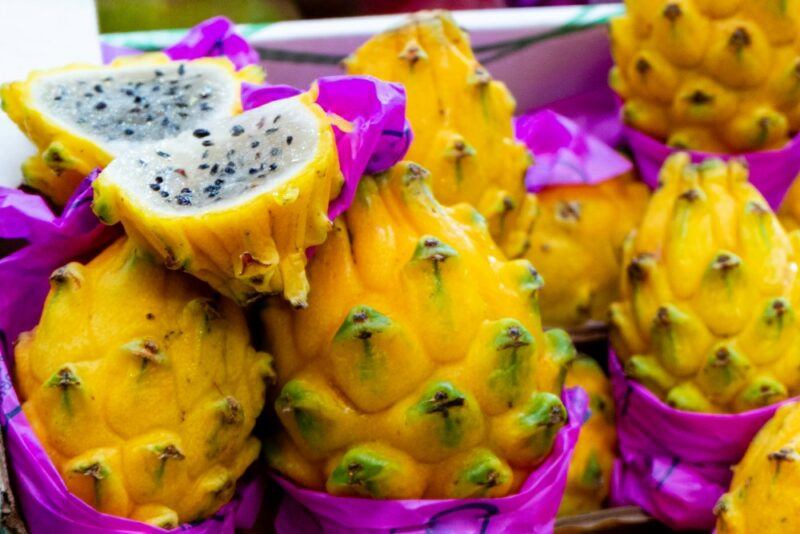
Dragon fruit are starting to become famous, which is why they feature in many exotic fruit boxes. The pulp is often white, sweet, and packed full of tiny black seeds.
The appearance makes dragon fruit a great addition to desserts. Dragon fruit chunks or balls work well in salads too, providing fantastic flavor contrast.
There are multiple varieties of dragon fruit, including some that have red flesh rather than white flesh. The skin color varies too. Red dragon fruit is the most common, but there are yellow dragon fruits as well.
Jackfruit
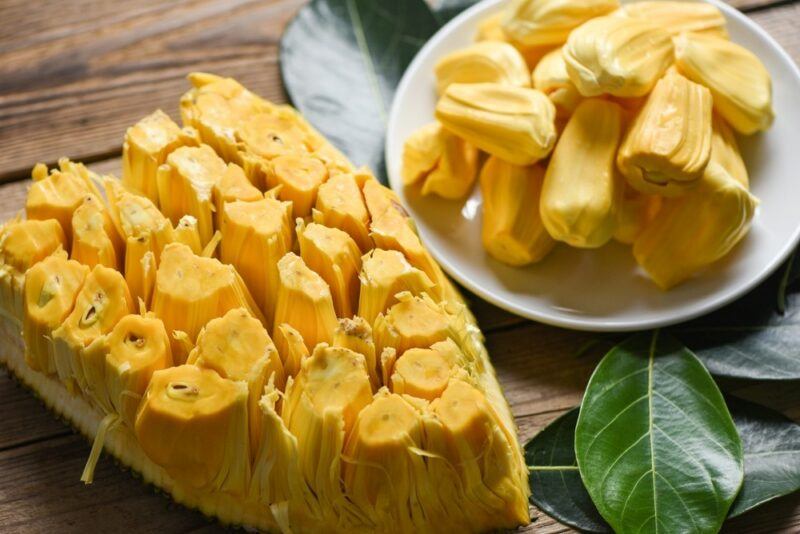
Jackfruit is an interesting entry. While the large fruit has a green exterior, the yellow pulp is the part that gets used.
You’ve probably heard about jackfruit before, as this exotic fruit has an unusual use – as a meat substitute (a popular one at that). Jackfruit flesh works well here because it is so stringy. The flavor can even be masked by some sauces.
This use of jackfruit has become so popular that it’s now easy to find cans and pouches of jackfruit flesh that you can use at home.
Barbadine
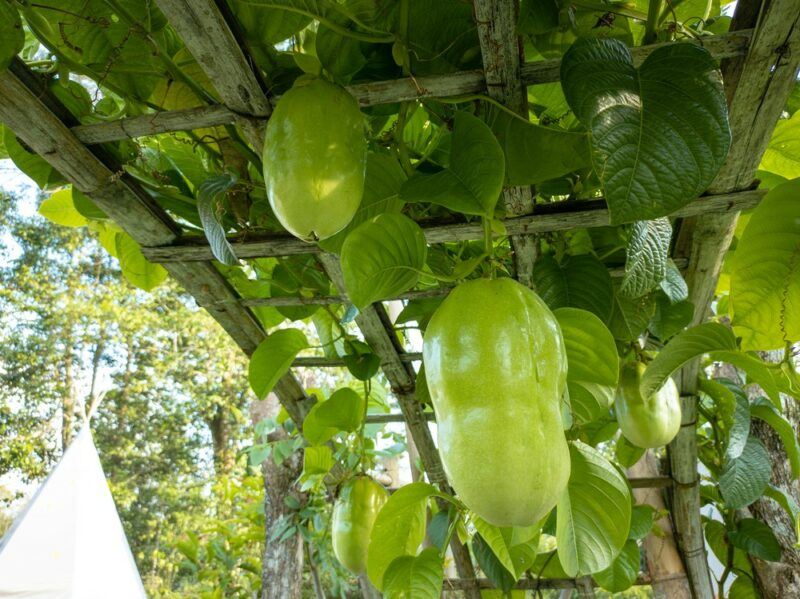
This fruit goes by the name barbadine or giant granadilla. It’s a melon-like fruit, often around 8 to 12 inches long. Like many fruits, it’s green when immature, then ripens to an orange-yellow color.
It’s a little like passionfruit in that the fruit has a sweet and delicious pulp. In fact, barbadine and passionfruit are actually related, although barbadine has a less intense flavor.
While the fruit can be eaten on its own, it is most often used as an ingredient in ice cream or punch.
Ciruela
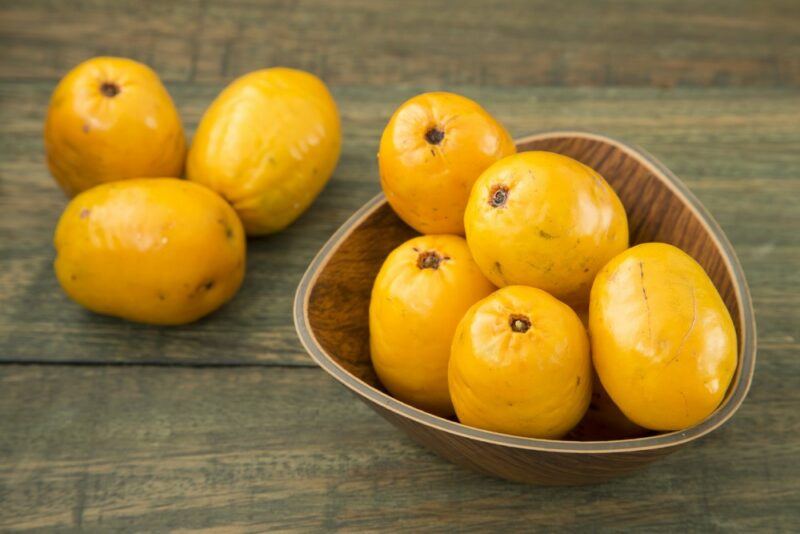
Ciruela goes by a few names, including Spanish plum and jocote. There are two main versions, one with red skin and the other with yellow skin instead.
Both types have yellow flesh underneath the skin, which is sweet and juicy. The taste is similar to regular plums, making them a surprisingly familiar exotic fruit.
Korean Melon
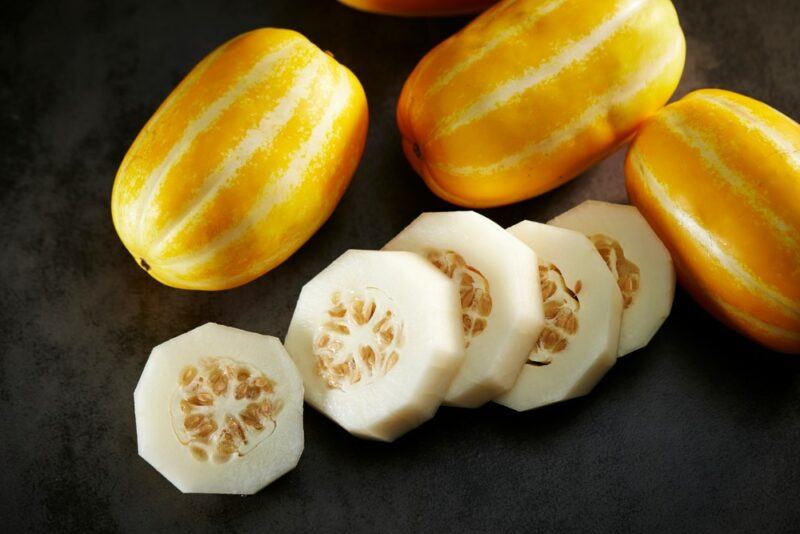
This interesting fruit is yellow (often bright yellow) on the outside, with contrasting white flesh. It is similar to a cantaloupe and honeydew in some ways, however, it can be described as both crisper and more delicious.
It’s also simply fantastic as an alternative to cantaloupe and honeydew, as those melons aren’t particularly popular.
The melon is also surprisingly small and has a thin skin, features that make it easy to work with. While you can eat the skin, many people peel the fruit first and eat the flesh.
Loquat
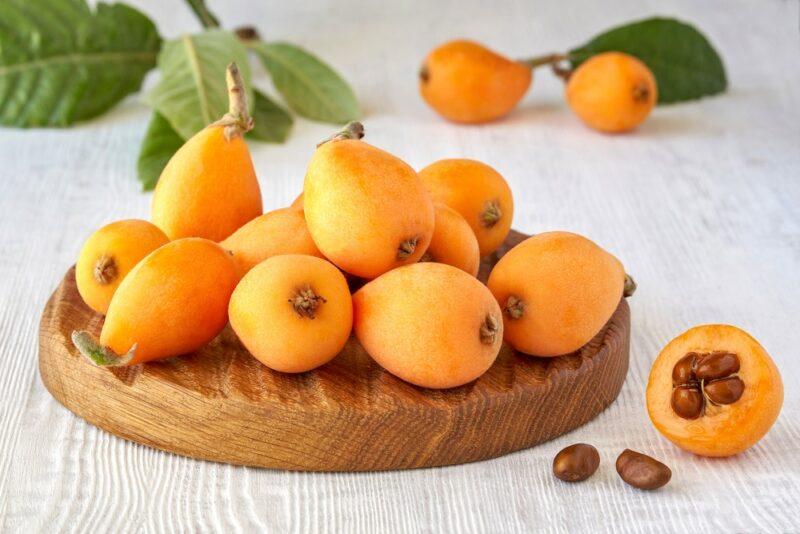
Loquat produces yellow-orange fruits, each with a single large seed in the center. The flesh of the fruit tends to be tangy, somewhat reminiscent of plums and apricots.
Indeed, the color, flavor, and texture of loquats should all be familiar, making this an excellent exotic fruit for beginners.
Pinkglow Pineapple
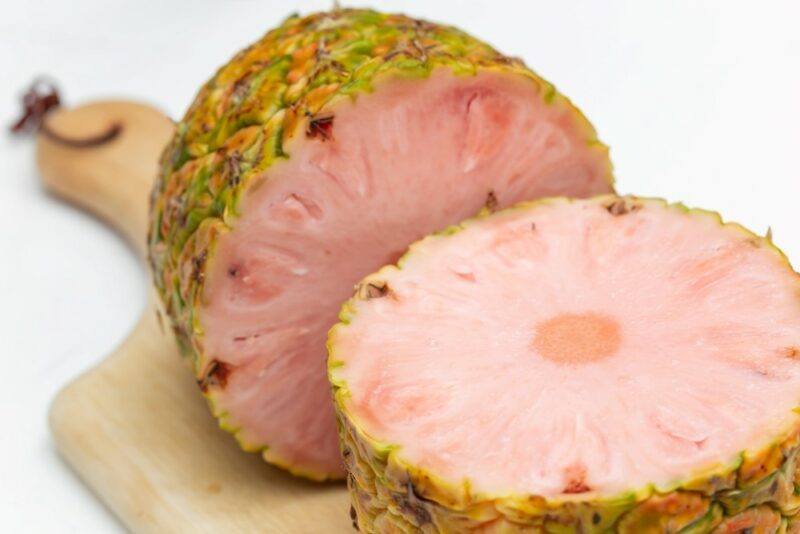
Pinkglow pineapples have the distinctive yellow exterior that we’ve come to expect from pineapples. However, the interior is very different. Rather than being yellow, the flesh is pale pink.
The flavor is subtler than a regular pineapple, with plenty of sweetness and a slightly floral taste. The pineapples aren’t a separate species, instead, they’re a separate cultivar, bred for their pink color.
There are other pink pineapple varieties out there too. Some of them can be ordered online or are shipped as part of exotic fruit boxes.
Lucuma
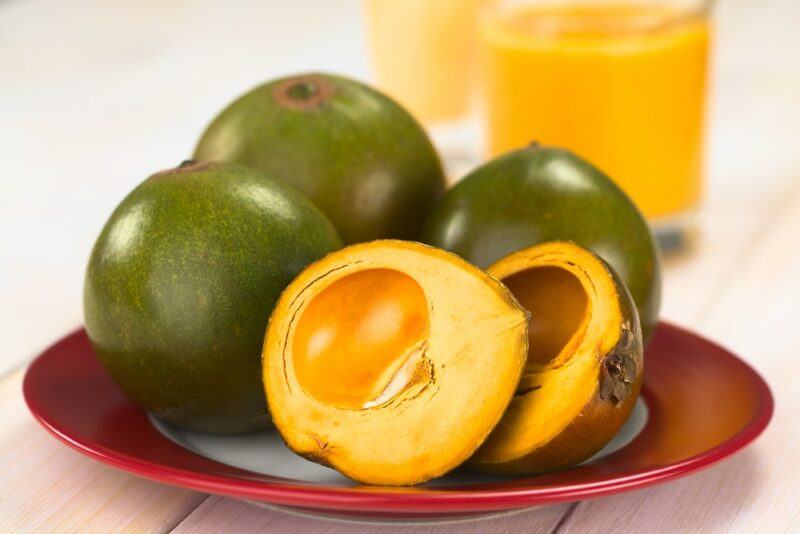
Lucuma is an interesting fruit. It’s green on the outside, but the yellow-orange flesh easily earns it a place on this list.
It’s unexpected, as unlike most fruits, lucuma isn’t particularly moist, nor does it have much juice. The flesh is almost crumbly instead. Indeed, lucuma is sometimes known as eggfruit because the consistency is surprisingly similar to a boiled egg yolk.
This texture means that lucuma fruits aren’t amazing to simply eat. Still, they’re often used as an ingredient. You can even buy lucuma powder to easily take advantage of the flavor.
The name eggfruit and the description might sound much like canistel, a fruit we talked about earlier. This is because the two fruits are very similar to each other. Canistel fruits tend to be a little moister and a bit fruitier, although you may find that you enjoy both types.
Lemon Guava
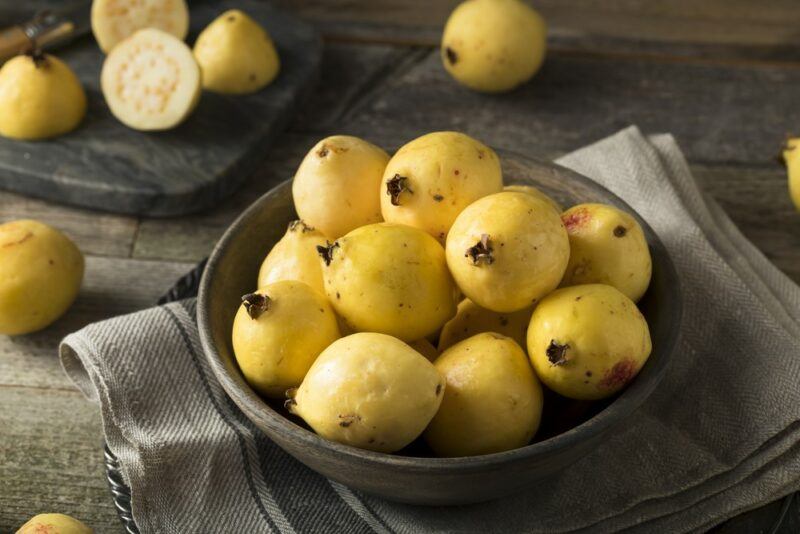
Regular guavas are fairly common these days. Lemon guavas are a completely different story.
These fruits are similar to a regular guava, except that they’re yellow inside and out. They’re often described as balanced, as the fruit has plenty of sweetness, plus just a little tanginess.
The flavor retains some citrus notes, with a touch of vanilla as well.
You won’t find these treats often, as they’re delicate and difficult to transport. However, they can be grown in some parts of the United States, so they sometimes show up in local farmer’s markets. You might even be able to grow your own.
Plantain
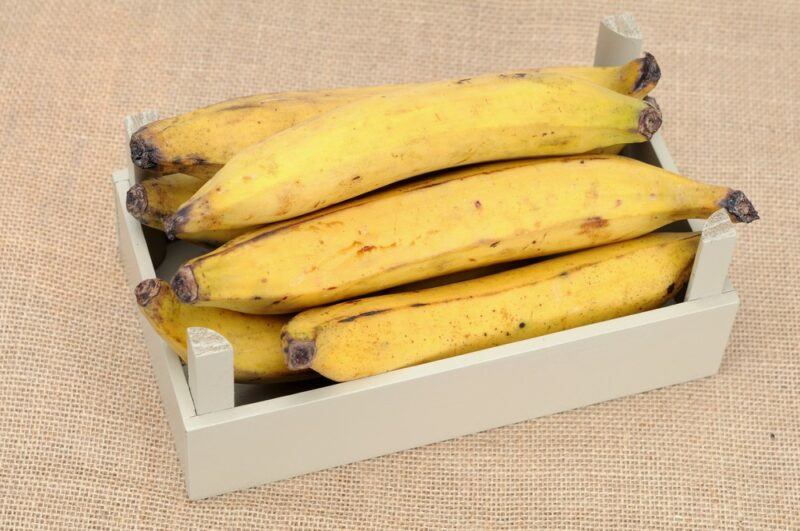
Plantains look like large bananas and even belong to the same family. But, we don’t eat them like bananas.
Because plantains are much starchier than bananas, they are normally cooked before being used. They’re not incredibly sweet either, so they’re often used in savory dishes.
Ugli Fruit
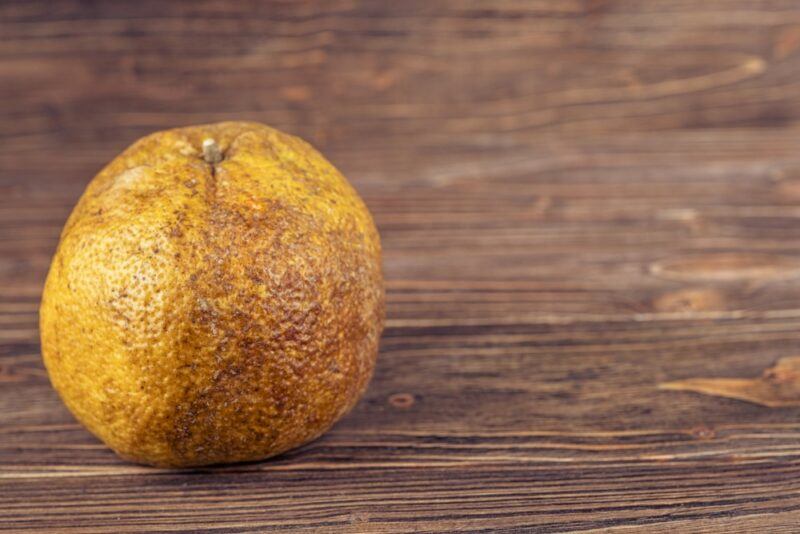
Ugli fruit matches the name, as the bumpy loose skin doesn’t look very good at all. The fruit sometimes has yellow skin, but can also be green or yellow-green instead.
Regardless, the skin easily peels off the fruit, revealing a similar interior to an orange. You can peel and eat an ugli fruit just like a regular grapefruit juice.
Praying Hands Bananas
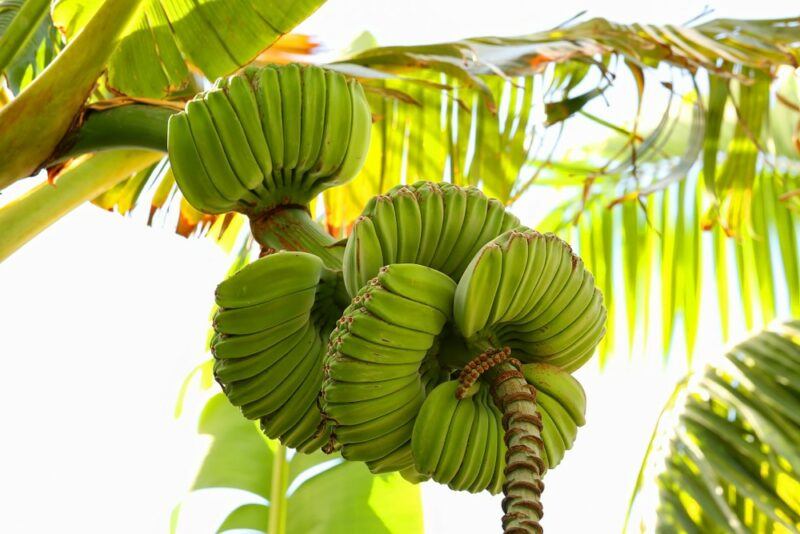
These fruits are a particularly unusual type of exotic banana. They grow as two ‘hands’ of bananas, each with around six or seven individual fruits. The two hands are fused together while growing, although they are relatively easy to separate when they’re ripe.
The bananas are often used cooked, just like plantains – often when they start to turn yellow. Younger bananas are particularly good in savory dishes, while riper ones may be used for sweet recipes instead.
You can eat the bananas raw too, but only when they are over-ripe and very soft.
Golden Kiwis

Golden kiwis squeeze their way onto this list as well – although only just. Unlike most other entries, these fruits aren’t yellow on the outside. Instead, they have an unusual brown fuzzy skin.
Their flesh is yellow though. They’re also sweeter than regular green kiwis and lack the distinctive flavor you get with green kiwis.
Are kiwis exotic? That depends on who you ask. They often feature on exotic food lists, but they’re also easy to find at grocery stores and farmer’s markets. While golden kiwis aren’t as common as green ones, they’re not rare.
Durian
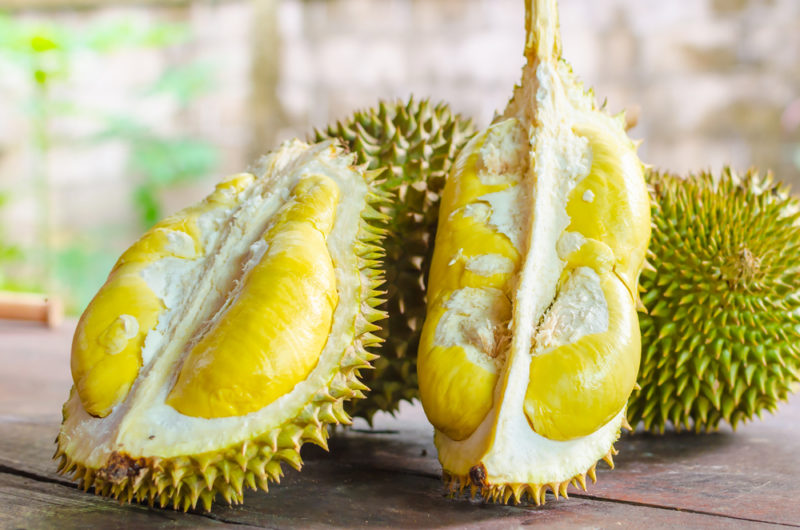
Like jackfruit, durians have a brown or yellow-brown exterior that’s covered in spikes. The interior is bright yellow, which is the part of the fruit that gets eaten.
The fruit is most famous for its large size and intense aroma.
Durian is also an acquired taste, with many people finding its scent to be extreme and distasteful. To make matters worse, the scent can linger for serval days. That’s awful news for anyone who hates the fruit.
Sweet Limes
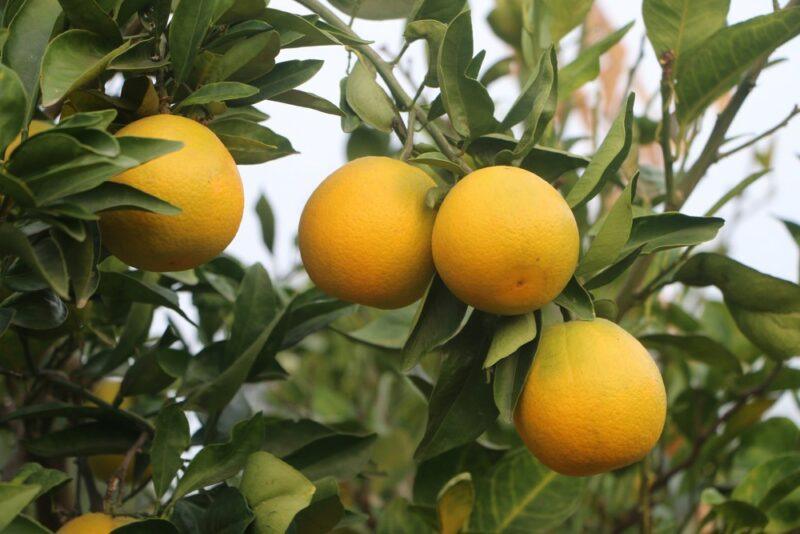
There are plenty of exotic citrus fruits, including sweet limes. These are curious fruit, as they’re yellow when ripe (despite being called limes). In fact, they look much like a lemon, but they’re sweeter than any lemon you’ve tried before.
The limes are often used for their juice, but you can also peel and eat them, just like an orange.
These are another fruit that varies in color. So, you’ll sometimes see varieties that are green when ripe.
Yuzu
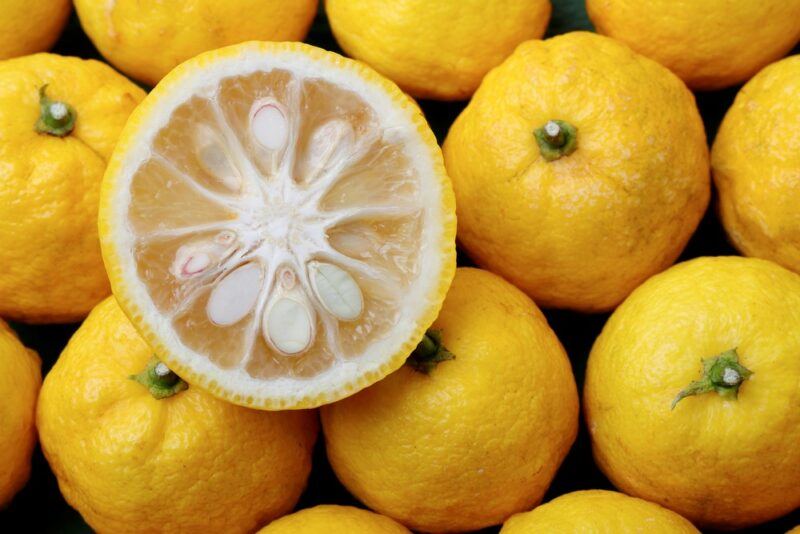
Yuzu is another type of citrus fruit. It’s traditionally found in East Asia, although cultivation has been spreading to other countries, making the fruit easier to find.
Despite huge production numbers, yuzu isn’t normally consumed as a fruit. The zest and juice are much more popular, particularly in Japanese cuisine.
If you’re in the United States, yuzu juice or other yuzu products are easier to find than the fresh fruit, especially as the citrus fruit can’t be imported into the country. However, it is being grown in California, so you may be able to order it online.
Custard Apple
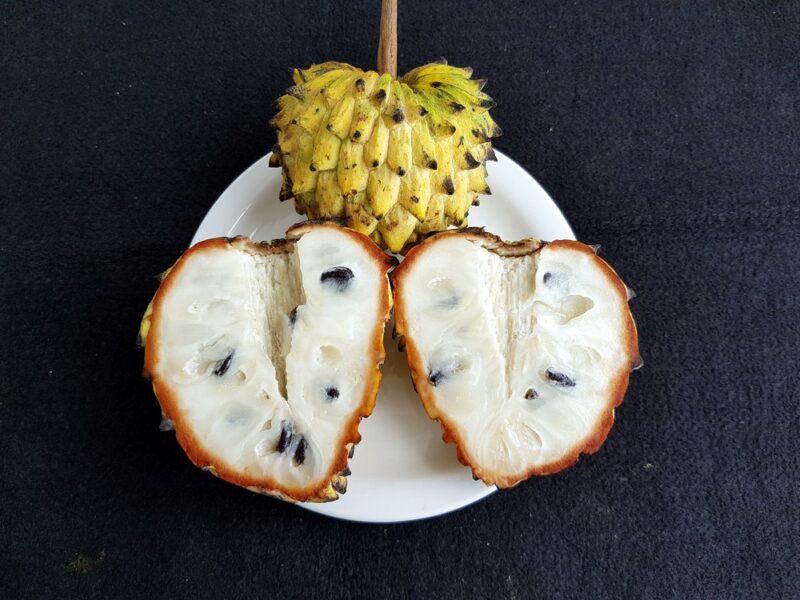
The custard apple is somewhat complex, as there are at least three related species whose fruits are known as custard apple, including Annona cherimola (also called cherimoya), Annona squamosa (also called sugar apple), and Annona reticulata.
There are also different varieties for each type, all with their own differences. This leads to variations in flavor and skin color. However, the fruits are almost always delicious, often with subtle and familiar nuances, often reminiscent of bananas, papayas, and peaches.
The term custard apple comes from the fruit’s texture, which is similar to custard. The fruits are often served chilled and sliced in half, giving you the chance to eat them with a spoon.
While custard apples mostly have green skin, there are some yellow-skinned varieties too, along with gradients between the two colors.
Rollinia Deliciosa
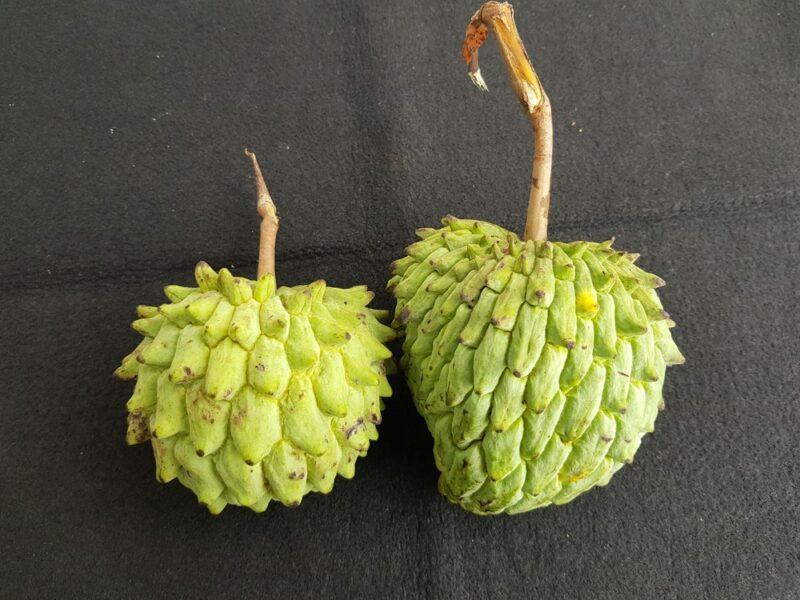
The rollinia deliciosa fruit belongs to the same family as the custard apple, although it has a distinctive appearance (again, sometimes green, sometimes yellow). You’ll also see it called wild sugar apple from time to time.
The fruit’s pulp has a sweet flavor that’s similar to a lemon meringue pie. It is mostly eaten raw, although is sometimes included in recipes too.
While the fruit is popular in tropical areas where it grows naturally, you won’t often find it in other parts of the world. Its short shelf life and delicate nature make transport extremely difficult.







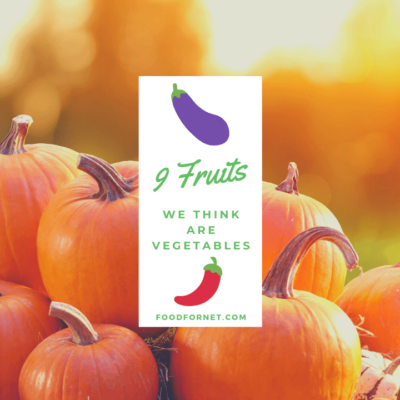
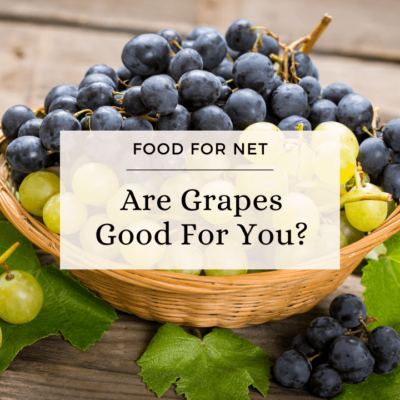

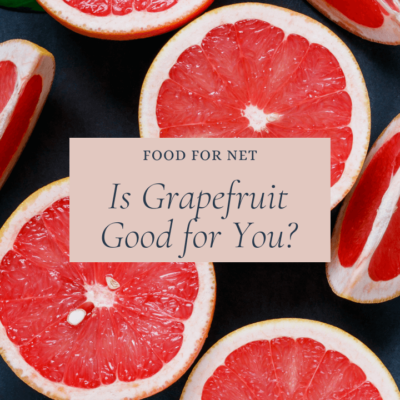



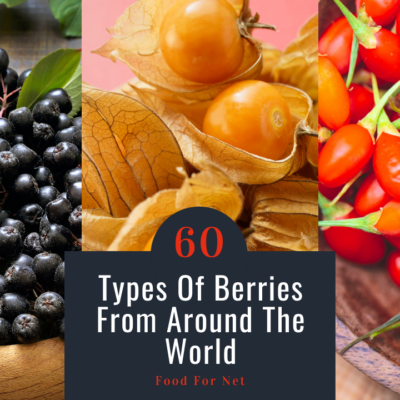


 5 Best Alkaline Water Brands
5 Best Alkaline Water Brands
Leave a Reply